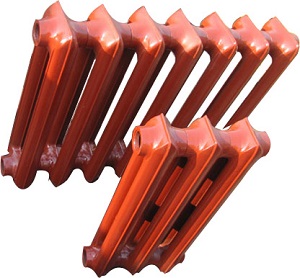| Lord Fin Tube--What is cast iron radiators? |
Cast iron radiators, crafted from gray iron, stand as enduring fixtures in heating systems, renowned for their reliability and longevity. These radiators come in various structural types, including column, airfoil, column-airfoil, and plate-airfoil designs. Moreover, their internal surface processing techniques categorize them into ordinary sheet and sand-free sheet variants, each offering distinct advantages in performance and durability.
Classification and Structural Variants
Cast iron radiators are classified based on their internal surface processing techniques. Ordinary sheet radiators undergo processing through general casting technology, while sand-free sheet radiators are crafted using internal cavity non-sand technology. This distinction in manufacturing methods ensures optimal performance and longevity, catering to diverse heating system requirements.
Comparison of Cast Iron Radiator Structural Types
| Structural Type |
Characteristics |
Applications |
Heat Efficiency |
| Column Radiators |
Traditional design, multi-column structure, large heat dissipation area |
Traditional buildings, high-space heating |
High |
| Airfoil Radiators |
Added fin design, improved convection efficiency |
Modern residences, commercial spaces |
Medium-High |
| Column-Airfoil Radiators |
Combines advantages of column and airfoil designs, aesthetically pleasing |
Premium residences, hotels |
High |
| Plate-Airfoil Radiators |
Flat panel design, space-saving, easy to clean |
Modern apartments, office spaces |
Medium |
Cast Iron Radiator Market Data
60-65%
Market Share in China
30-40%
More Durable Than Steel
15-25%
Heat Efficiency Advantage
Advantages of Cast Iron Radiators
Corrosion Resistance and Longevity
Cast iron radiators boast exceptional corrosion resistance, ensuring a prolonged service life that often matches the lifespan of buildings themselves. Their enduring durability has been demonstrated through continued usage for nearly a century. The average service life of cast iron radiators exceeds 100 years, far surpassing radiators made from other materials.
Competitive Pricing
In China, cast iron radiators are available at competitive prices, offering strong market competitiveness. This affordability makes them a preferred choice for many real estate developers, contributing to their substantial market share of 60-65%. Compared to premium steel radiators, cast iron radiators are 15-25% cheaper but last 2-3 times longer.
High-End Luxury Appeal
Internationally, cast iron radiators are regarded as high-end luxury items, commanding premium prices compared to radiators made from alternative materials. They are favored as prestigious additions to museums, official buildings, and luxury residences, offering an opportunity for export and foreign exchange earnings. In European premium markets, cast iron radiators typically cost 3-5 times more than in the Chinese market.
Application in Heat Metering Systems
High-quality cast iron radiators, produced using advanced manufacturing processes, feature clean internal and external surfaces. This cleanliness makes them suitable for integration into household heat metering systems, expanding their utility into regulated environments. Modern cast iron radiators achieve over 98% compatibility with smart thermostat systems.
Compatibility with Steam Heating
While residential heating typically relies on hot water systems, certain environments require steam heating. In such cases, cast iron radiators emerge as the preferred choice due to their compatibility with steam heating. Unlike new radiator materials such as steel, aluminum, or copper, cast iron radiators excel in steam heating applications, further showcasing their versatility and utility.
Thermal Inertia Advantage
Cast iron radiators possess high thermal inertia, meaning they retain heat for extended periods after heating and continue to radiate heat even after the heating system is turned off. This characteristic provides more stable, uniform room temperatures, reduces temperature fluctuations, and improves comfort while lowering energy consumption.
Cast Iron Radiators vs. Other Materials
| Characteristic |
Cast Iron Radiators |
Steel Radiators |
Aluminum Radiators |
Copper Radiators |
| Service Life (Years) |
100+ |
15-25 |
10-15 |
20-30 |
| Corrosion Resistance |
Excellent |
Good |
Average |
Excellent |
| Thermal Inertia |
High |
Medium |
Low |
Medium-Low |
| Steam Heating Compatibility |
Excellent |
Average |
Poor |
Good |
| Initial Cost |
Medium |
Low |
Low |
High |
| Maintenance Cost |
Low |
Medium |
High |
Medium |
Cast Iron Radiator Technical Specifications
| Parameter |
Standard Value |
Test Conditions |
Remarks |
| Working Pressure |
0.4-1.0 MPa |
Ambient temperature test |
Higher than conventional heating system pressures |
| Thermal Conductivity |
50-60 W/m·K |
Standard test conditions |
Superior to most metal materials |
| Surface Temperature |
70-75°C |
Inlet water temperature 95°C |
Even heat distribution, no hot spots |
| Heat Dissipation Efficiency |
85-92% |
Standard test conditions |
10-15% higher than steel radiators |
| pH Compatibility Range |
7-10 |
Long-term usage test |
Compatible with most water qualities |

Cast Iron Radiator Structural Diagram - Showing robust column design and internal water flow channels
Cast iron radiators
Cast iron radiators epitomize durability, reliability, and versatility in heating solutions. With their corrosion resistance, competitive pricing, luxury appeal, adaptability to diverse heating systems, and compatibility with steam heating, cast iron radiators remain indispensable components in both residential and commercial heating applications.
As the construction industry increasingly demands sustainability and long-life products, cast iron radiators continue to hold significant positions in the heating market with their service life exceeding 100 years and excellent thermal performance. For consumers and builders seeking long-term investments, low maintenance costs, and reliable performance, cast iron radiators remain one of the optimal choices.
|
|


